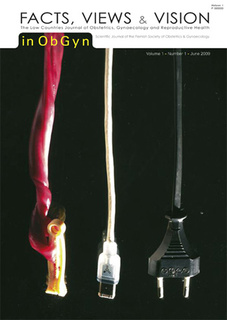“Nothing in biology makes sense except in the light of evolution”
—T. Dobzhansky (1900-1975)
This is the second issue of our new Journal Facts, Views and Vision. Two hundred years ago, the father of the Evolution Theory, Charles Darwin, was born and after decades of observation his landmark work ‘On the Origin of Species by means of Natural Selection, or the Preservation of Favoured Races in the Struggle for Life’ was published in 1859. This was followed by another book ‘The Descent of Man, and Selection in Relation to Sex (1871), in which Darwin tried to make evolutionary sense out of the different phenotypes between males and females. His work has revolutionized our vision on the evolution of life in general and human life in particular . In this bicentennial year of Charles Darwin’s birth many journals have published editorials and reviews on the Evolution Theory. Reproduction being a central issue of this journal it is appropriate to devote an editorial on the evolutionary aspects of human reproduction.
For this occasion we invited a paper from a professor in Ecology, the science that studies the interaction between species and their natural environment, to write a personal view on evolution with particular emphasis on the evolution of human reproduction. In several chapters he describes how reproductive strategies and behaviour evolved over eons. It all starts with the beginning of sexual reproduction and the evolution of male and female gametes of different size and characteristics. From this apparently simple divergence in gametes evolved all differences in sexual anatomy, physiology and sexual behaviour between males and females. For lay persons with an anthropocentric view it may be difficult to understand and accept that basic evolutionary mechanisms also apply to humans and that evolution also has shaped human reproduction and reproductive behaviour. To paraphrase an aphorism by Jacques Monod: ‘What is true for E. Coli is also true for the elephant’ we can say that ‘What is true for the elephant is also true for humans’. As explained in the paper by Prof. J. Mertens, many human reproductive phenomena, e.g. from mate selection, monogamy or polygamy, parental care, jealousy and menopause and even homosexuality and masturbation are driven by the principle of maximal reproductive fitness. You will come across a few esoteric words and terms, such as iteroparous, semelparous, filopatric, patrilocal, specific to the domain of ecology, but these terms become self-evident within the context.
Evolution is characterised by a balance between competition and cooperation. This two principles not only apply to many biological reproductive processes, from sperm competition to pregnancy, but also to many social activities such as sports, politics, science etc.. Excessive leaning towards competition, however, may herald doom. The story of the Y-chromosome is a prime biological example of such a potentially self-destructive behaviour . About 150 million years ago, the Y-chromosome went its own way. Before, it was equivalent to the X-chromosome and paired with the X-chromosome in the prophase of the meiotic division. At this stage chromosomes pair and exchange information and genetic damage of one allele can be restored by copying the correct genetic version. At some time, the Y-chromosome stopped the pairing dance with his X-homologue, except for a small chromosomal region and ceased swapping genes,. This led to the gradual loss of all somatic genes leaving the Y-chromosome with a dozen of genes of which almost all are dedicated to sperm formation and male sexual development. Hence, the Y-chromosome has become a sad shrunken vestigial thing only dedicated to sex while the X has remained a bold, full size chromosome with plenty of vital genes. A few years ago, some scientists predicted that in a dozen million years, the Y-chromosome will have lost all its functions and disappear. The recent finding of a completely normal and presumably fertile XY female indeed doesn’t bode well for the future of the Y-chromosome (Biason-Lauber A et al., 2009).
Gynaecologists are intimately involved in reproduction and many of us
handle gametes and embryos, but have we ever given it a moment’s thought
how from this tiny embryo a complete organism develops at a breakneck speed.
Darwin’s close ally, Thomas H. Huxley, remarked in Aphorisms and Reflections
(1907):
‘...of all the perennial miracles she (Nature) offers to his (the student
of Nature) inspection, perhaps the most worthy of admiration is the development
of a plant or of an animal from its embryo.’ The puzzle of how a simple
egg gives rise to a complete individual stood for a long time as one of
the most elusive questions in biology. The sequencing of the genome of
several species revealed a surprising finding. Not only were humans endowed
with far less genes than previously thought but how too explain that species,
as diverse as a human and a mosquito, share a lot of the same genes. Mice
and human have virtually identical sets of about 25.000 genes and chimpanzees
and humans are nearly 99 percent identical at the DNA level. If the sets
of genes are so widely shared, how do differences arise? How to resolve
the paradox of great phenotypic diversity and genetic similarity? Apparently,
the answer is not to be found in the tiny fraction (a few percent) of DNA
that codes for all kind of proteins. A larger part of DNA is involved with
the regulation of the expression of the some master genes or tool kit genes,
which are shared by most animals. This regulatory DNA integrates information
about the location in the embryo and the timing of development. The switching
on and off of these master genes by regulatory genes during embryo development
plays a major role in the phenotypic diversity. The integration of evolution
and developmental biology is the topic of a relatively new scientific branch
briefly called Evo Devo. For those interested in this remarkable new field,
I would recommend the fascinating book by Sean B. Carroll: ‘Endless Forms
Most Beautiful’ (2005). The title of this book is an excerpt from the last
sentence of ‘On the Origin of Species’ published 150 years ago “... from
so simple a beginning endless forms most beautiful and most wonderful have
been, and are being, evolved”.
References
- Biason-Lauber A, Konrad D, Meyer M, DeBeaufort C, Schoenle EJ. Ovaries and female phenotype in a girl with 46,XY karyotype and mutations in the CBX2 gene. Am J Hum Genet. 2009;84:658-63.
- Sean D. Carroll. Endless Forms Most Beautiful. The New Science of Evo Devo and the making of the Animal Kingdom. W.W. Norton&Company, New York London, 2005.
Marc Dhont
Ghent University
Department of Obstetrics and Gynaecology
Co-editor-in-Chief



